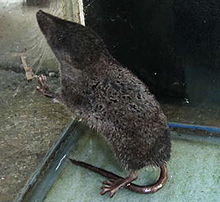Asiatic water shrew
The Beavers shrews or Asiatic water shrews ( Chimarrogale ) form a living in East and Southeast Asia shrew genus with six species.
Features
Beaver shrews are similar in physique to the European water shrews, but are much larger. Like these, they show some adaptations to an aquatic lifestyle: the feet are equipped with a Borstensaum that allows such a webbed the rapid progress in the water. The eyes are small, as are the ears that can be closed. The coat is dense and water repellent, it is greyish to black in color at the top, often with bright mottles, the underside is lighter. These animals can reach a body length 8-14 cm, a tail length of 6-12 cm and a weight from 27 to 43 grams.
Dissemination and lifestyle
The distribution of beaver shrews ranges from the Kashmir region and Japan on China and the Malay Peninsula to Sumatra and Borneo. Their habitat is rivers in mountainous areas up to 3300 meters above sea level.
You can well swim and dive and feed on insects and their larvae, crustaceans and fish.
Because of water pollution and the destruction of their habitat several species are endangered. Two species are listed by the IUCN as threatened with extinction ( critically endangered ).
The types
- The Malayan water shrew ( Chimarrogale hantu ) lives in the south of the Malay Peninsula and is considered threatened with extinction.
- The Himalayan water shrew ( Chimarrogale himalayica ) is distributed from Kashmir over southern China and Taiwan to Thailand.
- The Bornean Water Shrew ( Chimarrogale phaeura ) is endemic to Borneo and is considered threatened.
- The Japanese water shrew ( Chimarrogale platycephala ) lives in Japan.
- The Chinese water shrew ( Chimarrogale styani ) is native to southern China and northern Myanmar.
- The Sumatra water shrew ( Chimarrogale sumatrana ) is endemic to Sumatra. The species inhabits only a small area in the west of the island and is listed as threatened with extinction.




-during-the-late.png)





